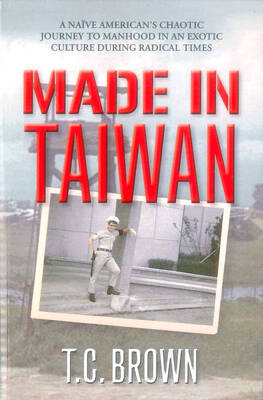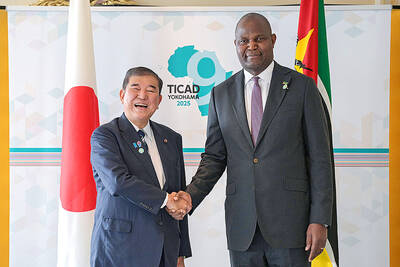North Korean leader Kim Jong-un’s possible trip to Russia might be like his first one in 2019 — a rattling, 20-hour ride aboard a green-and-yellow armored train that is a quirky symbol of his family’s dynastic leadership.
In what would be his first foreign travel since the start of the pandemic, US officials say Kim may visit Russia this month for a meeting with Russian President Vladimir Putin, possibly to advance talks on North Korean arms sales to refill Russian reserves drained by its war on Ukraine.
According to US reports, a potential venue for their meeting is the eastern city of Vladivostok, the site of their first meeting in April 2019, where Putin is expected to attend the annual Eastern Economic Forum that takes place on the campus of the Far Eastern Federal University from Sunday to Wednesday.

Photo: AP
How Kim, the 39-year-old authoritarian leader, would get there is a focus of media attention.
While Kim has used planes more frequently than his famously flight-averse father, he has also used his family’s armored train for his previous meetings with Putin, Chinese President Xi Jinping (習近平), and then-US President Donald Trump in 2018 and 2019, reviving an old symbol that has long been part of the Kim dynasty’s lore.
Putin, for his part, now prefers to avoid airplanes and travel on a special armored train since his decision to invade Ukraine early last year, according to Gleb Karakulov, a defector from Putin’s secretive elite security service.

Photo: AP
Kim’s earlier meeting with Putin required a daylong trip that began at the North Korean capital of Pyongyang and chugged over the country’s aging railways along the eastern coast before crossing a border river into Russia.
Kim went to China four times from 2018 to 2019 to meet Xi — two of them by his train and the other two by his private Russian-made jet. In June 2018, he borrowed a Chinese Boeing 747 plane to fly to Singapore for his first summit with Trump, reportedly because his jet was deemed unsafe. For his second meeting with Trump in February 2019 in Hanoi, Vietnam, Kim took his train for a two-and-half day trip.
Kim’s meetings with Xi and Putin surrounded his high-stakes diplomacy with Trump, where he attempted to leverage his nukes for badly needed economic benefits. The Kim-Trump diplomacy eventually collapsed after their Hanoi meeting.

Photo: AP
Since closing his country’s borders in early 2020 to guard against the COVID-19 pandemic, Kim hasn’t met any foreign leader.
Kim’s possible second trip to Russia could signal a restart of a summit-driven diplomacy and may be followed by a trip to China for a meeting with Xi, said Yang Moo-jin, president of the University of North Korean Studies in South Korea.
Kim’s father, Kim Jong-il, made about a dozen trips abroad during his 17-year rule, almost all to China and all by train. North Korea’s state media said that Kim Jong-il died of a heart attack during a train trip in 2011.
According to an account published in 2002 by Konstantin Pulikovsky, a Russian official who accompanied Kim Jong-il on a three-week trip to Moscow a year earlier, the train carried cases of expensive French wine and passengers could feast on live lobster and pork barbeque.
The train’s most important feature, however, would be security. According to South Korean media reports, North Korea has 90 special carriages in total and operates three trains in tandem when a leader is traveling — an advance train to check the rails, the train with the leader and his immediate entourage, and a third train behind for everyone else. High-tech communication equipment and flat-screen TVs are installed so a leader can give orders and receive briefings.
A life-size mock-up of one of the train’s carriages is on permanent display at a mausoleum on the outskirts of Pyongyang where Kim Jong-il and his state-founding father, Kim Il-sung, lie in state.
It’s not immediately clear whether Kim Jong-un would choose to travel to Russia on a train again when he seems equally comfortable with flying. When Kim jetted off to the northeastern Chinese city of Dalian in May 2018 for his second meeting with Xi, he became the first North Korean leader to fly abroad in 32 years. The last time a North Korean leader had publicly gone abroad by air had been Kim Il-sung’s flight to the Soviet Union in 1986.
Schooled for several years in Switzerland, Kim Jong-un is believed to have traveled by air often as a teenager. Since taking office upon his father’s death in December 2011, Kim had also occasionally flown inside North Korea. Kim’s official plane is a remodeled version of the Soviet-made IL-62. North Korea calls it “Chammae-1,” named after the goshawk, North Korea’s national bird.
South Korean media say the plane can fly at a maximum speed of 900km per hour and carry about 200 people. Its maximum flight range is about 9,200km but it has reportedly never flown that far. State media said Kim was aboard Chammae-1 when he reviewed air force planes taking part in combat aeronautics contests and inspected construction work in Pyongyang.
Some analysts are skeptical whether Kim’s meeting with Putin would happen next week on the sidelines of the Eastern Economic Forum because he and his predecessors have preferred one-on-one summitry when making their rare trips abroad.
Still, there are growing expectations for a meeting as it’s clear Kim’s and Putin’s interests are aligning in the face of their deepening, separate confrontations with the US.

Under pressure, President William Lai (賴清德) has enacted his first cabinet reshuffle. Whether it will be enough to staunch the bleeding remains to be seen. Cabinet members in the Executive Yuan almost always end up as sacrificial lambs, especially those appointed early in a president’s term. When presidents are under pressure, the cabinet is reshuffled. This is not unique to any party or president; this is the custom. This is the case in many democracies, especially parliamentary ones. In Taiwan, constitutionally the president presides over the heads of the five branches of government, each of which is confusingly translated as “president”

By 1971, heroin and opium use among US troops fighting in Vietnam had reached epidemic proportions, with 42 percent of American servicemen saying they’d tried opioids at least once and around 20 percent claiming some level of addiction, according to the US Department of Defense. Though heroin use by US troops has been little discussed in the context of Taiwan, these and other drugs — produced in part by rogue Chinese Nationalist Party (KMT) armies then in Thailand and Myanmar — also spread to US military bases on the island, where soldiers were often stoned or high. American military policeman

An attempt to promote friendship between Japan and countries in Africa has transformed into a xenophobic row about migration after inaccurate media reports suggested the scheme would lead to a “flood of immigrants.” The controversy erupted after the Japan International Cooperation Agency, or JICA, said this month it had designated four Japanese cities as “Africa hometowns” for partner countries in Africa: Mozambique, Nigeria, Ghana and Tanzania. The program, announced at the end of an international conference on African development in Yokohama, will involve personnel exchanges and events to foster closer ties between the four regional Japanese cities — Imabari, Kisarazu, Sanjo and

The Venice Film Festival kicked off with the world premiere of Paolo Sorrentino’s La Grazia Wednesday night on the Lido. The opening ceremony of the festival also saw Francis Ford Coppola presenting filmmaker Werner Herzog with a lifetime achievement prize. The 82nd edition of the glamorous international film festival is playing host to many Hollywood stars, including George Clooney, Julia Roberts and Dwayne Johnson, and famed auteurs, from Guillermo del Toro to Kathryn Bigelow, who all have films debuting over the next 10 days. The conflict in Gaza has also already been an everpresent topic both outside the festival’s walls, where